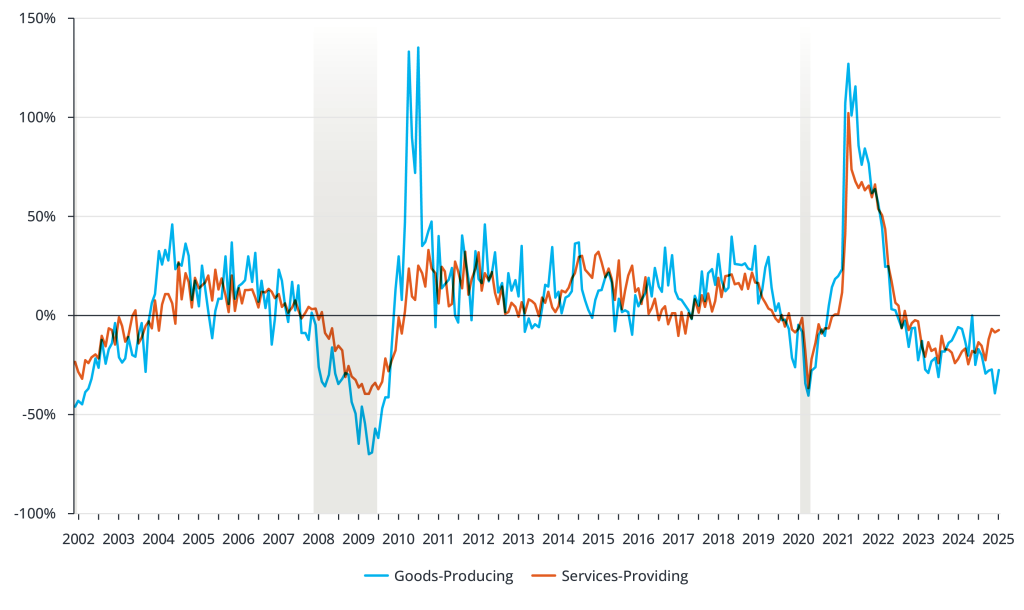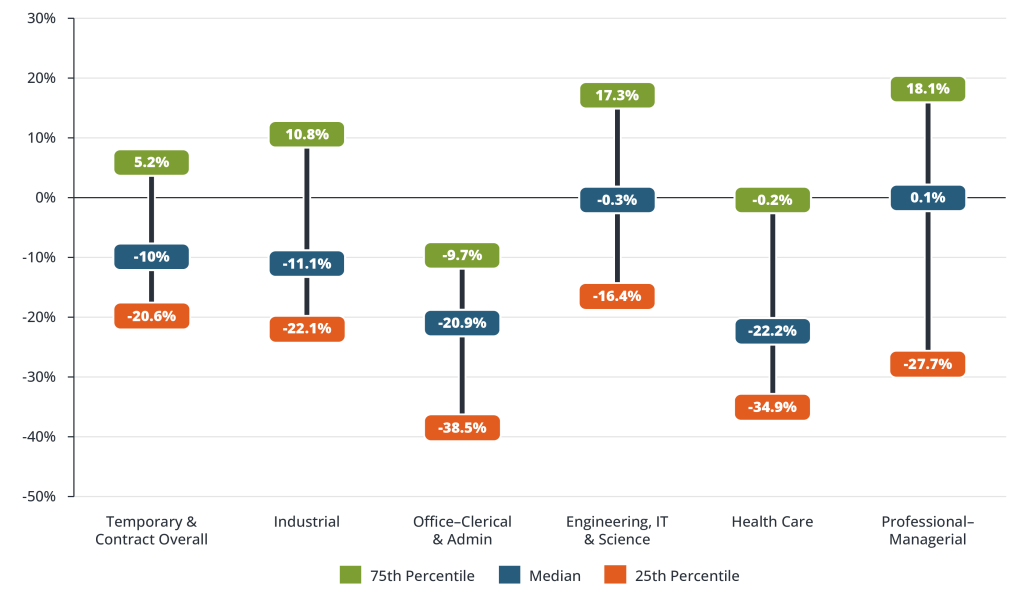Over the past year, goods-producing sectors such as construction and manufacturing have experienced greater deceleration in job openings than their service-providing counterparts, suggesting employers have reduced their long-term expectations for adding headcount.
Weekly Economic Outlook
04/02/2025
U.S. Labor Market Momentum: The Great Divide
Incoming labor data may provide further evidence of a growing divide in labor market momentum between goods-producing and service-providing segments of the economy. Over the past year, goods-producing sectors such as construction and manufacturing have experienced greater deceleration in job openings than their service-providing counterparts, suggesting that employers have reduced their long-term expectation to add headcount. This shift annunciates the disparate effects of recent economic policy changes on goods-producing sectors, which are much more likely to experience major swings in demand for labor due to changing economic policies, especially tariffs.
Tariffs are primarily applied to goods which businesses can either sell directly to consumers at a higher price or incorporate as intermediate inputs into their own products that are also sold to consumers at a higher price. Research shows 80% of goods affected by the tariffs on Canada, Mexico, and China are primarily utilized by the manufacturing sector, which means such firms will be forced to charge customers more for their products, yielding reduced demand and profits. Firms anticipate that they will not be in a growth-oriented position to add headcount, which is why employers in goods-producing sectors are cutting back on job openings as well as hiring candidates for such roles.
The lack of labor market momentum in goods-producing sectors could have major implications for the staffing industry. According to ASA research, almost 50% of staffing employees work in the light industrial space, including the construction and manufacturing sectors. Similarly, nearly one-third of total staffing employment is in transportation and material moving occupations. These two metrics suggest the labor market for goods-producing segments of the economy is critical for the recovery in temporary help services. Should incoming labor market data suggest further deceleration, it could portend an even longer recovery for temporary help services employment as well as sales.
YOY Change in Job Openings: Goods-Producing vs. Service-Providing Sectors

Weekly Staffing Research Outlook
04/02/2025
While economic uncertainties will likely adversely impact the pace of recovery in the short term, the return to growth in the fourth quarter is a promising signal that the industry is on a path back toward normalization.
Staffing Employment Data May Preview Growth on the Horizon
U.S. staffing companies employed an average of around 2.2 million temporary and contract workers per week in 4Q2024, up 37,000 jobs from the third quarter, according to data released last week from the ASA Staffing Employment and Sales survey. The quarter-to-quarter gains in staffing employment mark the first quarter of growth in two years (since 4Q2022). In addition to the quarterly uptick in staffing employees the year-to-year gap in employment continued to narrow.
During all of 2024, staffing companies provided employment to 11.2 million temporary and contract employees, down from 12.7 million employed in 2023. Anxieties surrounding macroeconomic and geopolitical conditions dampened hiring and job creation across most sectors in 2024, and these concerns have only heightened in the wake of recent events and speculations. While economic uncertainty will likely adversely impact the pace of recovery in the short term, the return to growth in the fourth quarter is a promising indication that the industry is on a path toward normalization.
The ASA quarterly survey focuses on staffing sales and employment but also delivers additional critical metrics. The quarterly report provides key employment, payroll, sales, and gross margin benchmarks for staffing firms, with select breakouts by industry sector and company sales size. Analyzing sales by industry sector, health care saw the greatest median decline year-to-year (-22.2%) while the professional-managerial sector saw the greatest median increase, eking out a gain of 0.1% in sales from 4Q2023 to 4Q2024. How does your company compare? Find out by registering for the 1Q2025 survey, which opens April 4.
Year-to-Year Change in Staffing Sales by Sector—4Q2024



